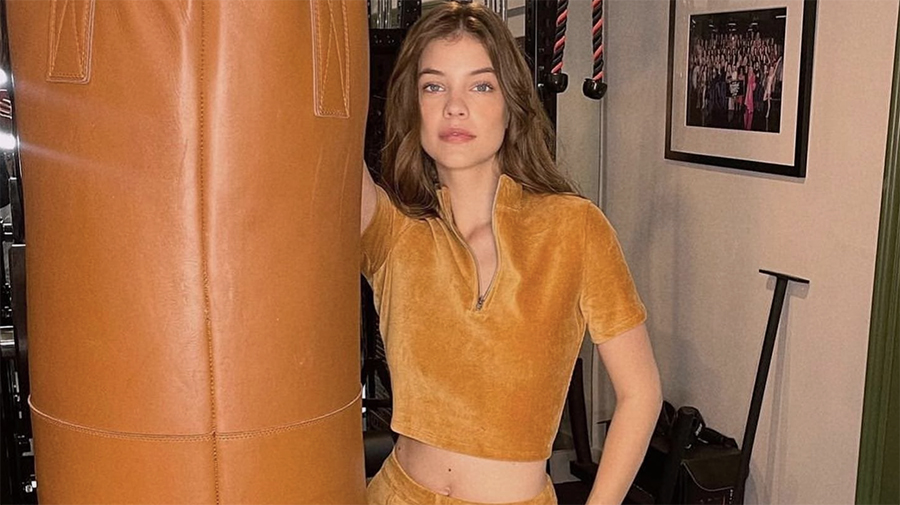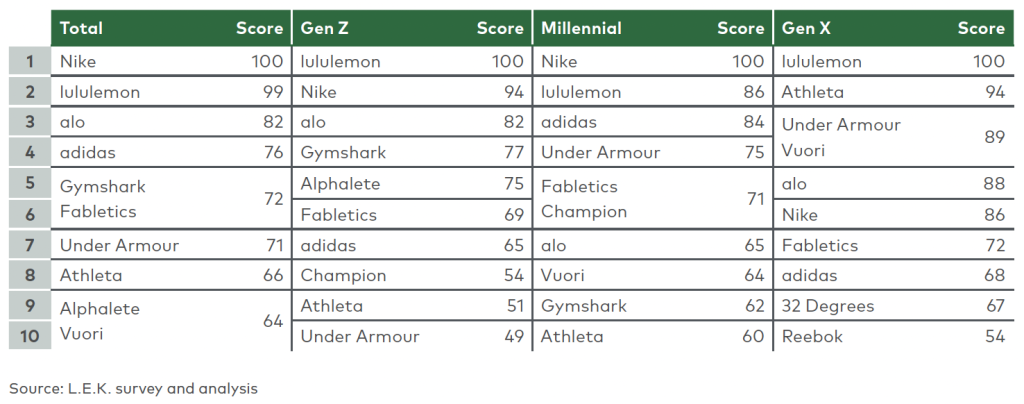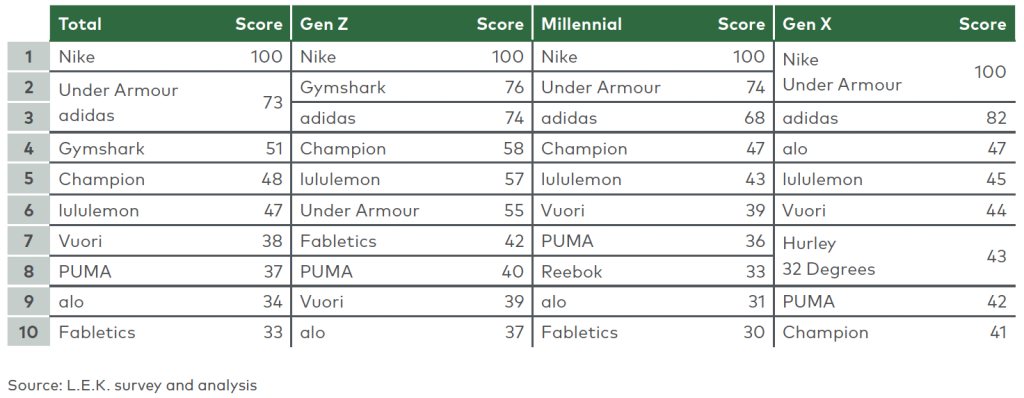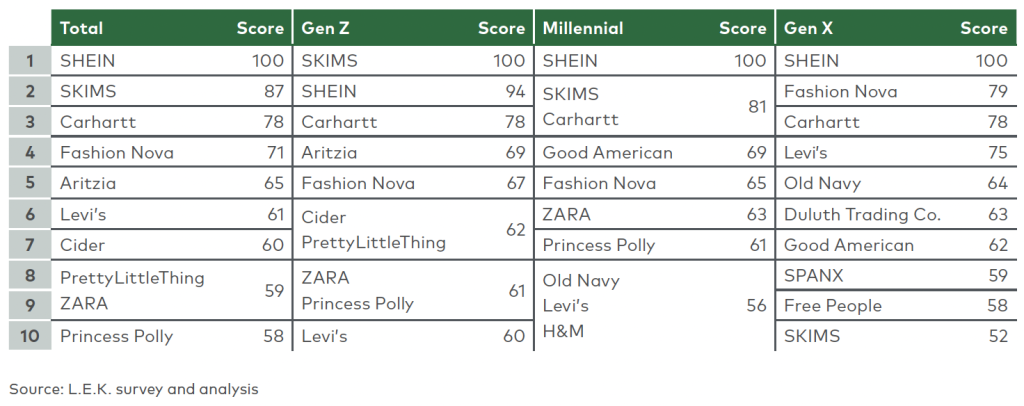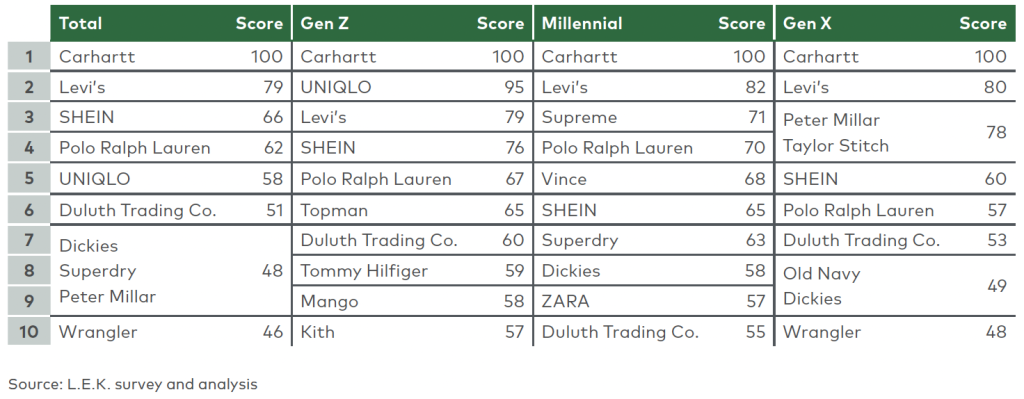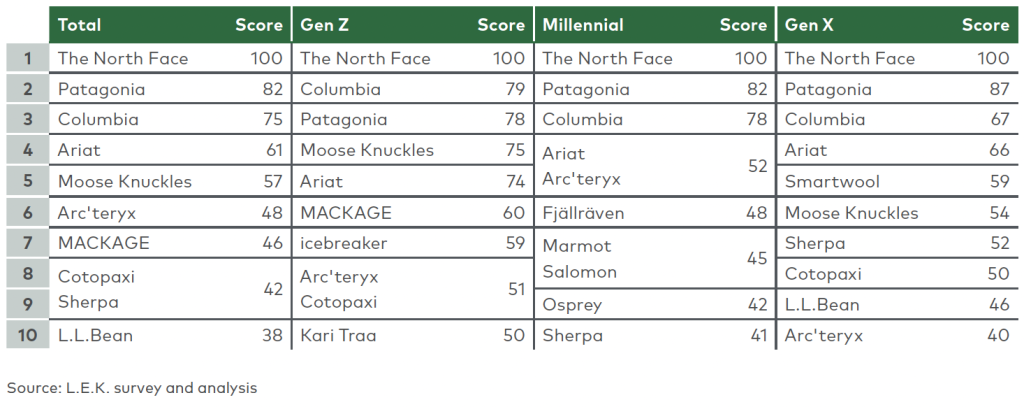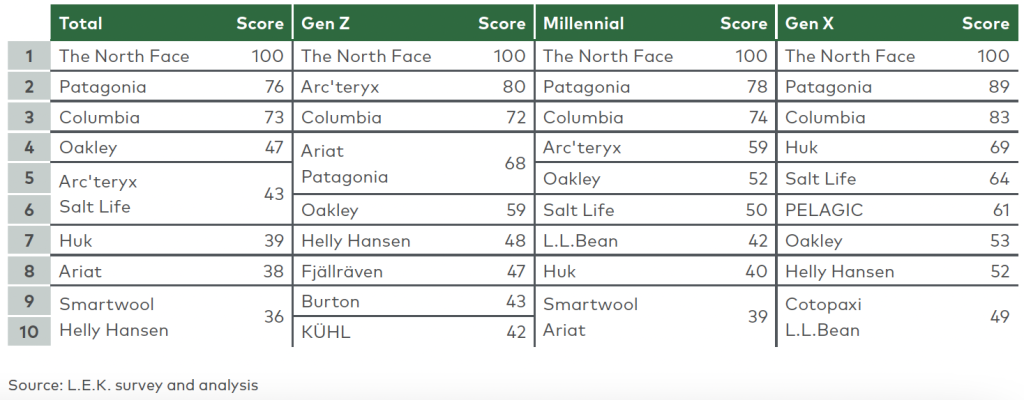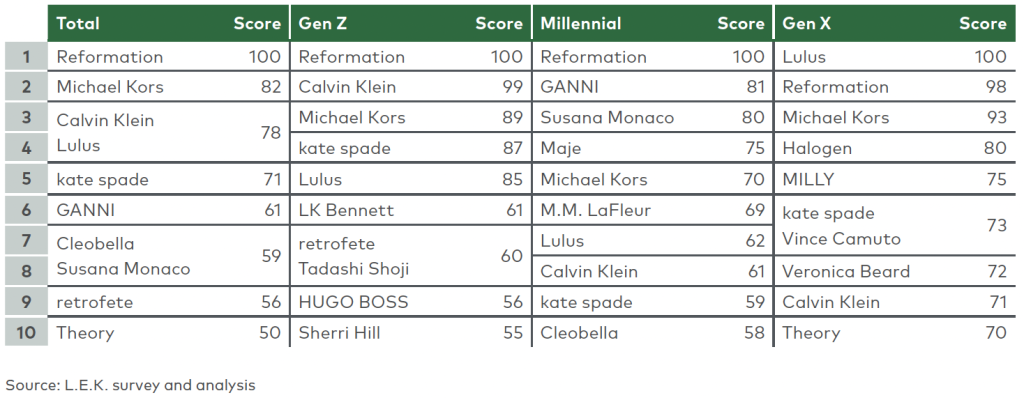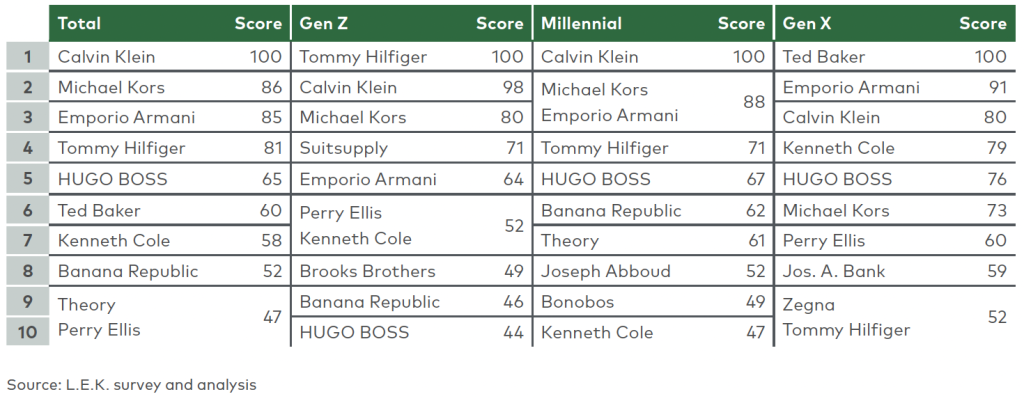L.E.K. Consulting released its third annual Brand Heat Index, revealing which brands have gained in popularity or increased brand “heat” across the major product categories in women’s and men’s footwear and apparel.
While L.E.K. Consulting featured many top brands in its 2023 report, including HeyDude, Nike, Shein, and Carhartt, who continue to lead in their respective categories, its 2024 rankings showed that some legacy brands felt the heat from the relative newcomers. For example, On remained on top in women’s athletic footwear after initially surpassing Nike in 2023, with Hoka not far behind, while Lululemon closed the gap with Nike in women’s athletic apparel.
The shake-up is not only in the athletic space, as Reformation replaced Michael Kors as the top brand in women’s dress apparel, and Skims moved in on Shein for the top spot in women’s casual clothing, with Shein also dropping to third in men’s casual clothing.
“This year’s results continue to demonstrate the relevance of newcomer brands, as many brands across the Top 10 lists were not household names ten or even five years ago, and now they’re nearing, or even out-pacing, the heat of some of the historically most powerful brands in the industry. That represents a major change in the competitive landscape,” said L.E.K. Managing Director and Co-Author Jon Weber of the 2024 U.S. Footwear and Apparel Brand Heat Index.
L.E.K. surveyed nearly 4,000 U.S. consumers between the ages of 14 and 55 to compile its 2024 Brand Heat Index. Within product categories and generational cohorts, each brand earned a heat score of 0 to 100; the higher the score, the hotter the brand. The consulting company tested around 450 brands to compile this year’s report and to understand their popularity and the key factors behind it. The survey culled feedback on brands across four product categories: athletic, casual, outdoor/rugged and dress.
In apparel, the usual suspects in fast fashion, Shein and Fashion Nova, still dominate casual clothing, though other fast fashion brands have climbed the women’s rankings, including Princess Polly and Cider. Social media and digital marketing helped catalyze the brands’ rise, prompting others to develop similar strategies to appeal to younger generations.
Also, in the casual category, workwear brands, including Carhartt (#1 for men’s casual and #3 for women), remained popular. In contrast, an increased number of specialized, technical brands reached the Top 10 in the outdoor apparel category, including Ariat across genders and Huk, Salt Life, and Pelagic for men.
Like footwear, the apparel rankings highlighted several clothing brands’ consistently strong performers across genders and generations. For example, Nike is the top athletic apparel brand for men and women, while The North Face, Columbia and Patagonia are the top three in women’s and men’s outdoor apparel. Casual and dress apparel show more brand variation across genders, but Shein, Carhartt, Michael Kors, and Calvin Klein exhibit broad appeal.
“There can be material variations in how different generations and genders perceive a brand. It’s critical for brands to understand where these differences lie to develop the strategies required to maximize strengths and address weaknesses,” said Chris Randall, L.E.K. managing director and survey report co-author.
Athletic Clothing
There is a meaningful overlap in the leading brands across genders in athletic clothing. Nike came in as the top brand in men’s and women’s athletic clothing while eight of the Top 10 brands overlapped in both lists.
In women’s athletic clothing, Lululemon continues to inch closer to Nike at the top of the list, with both brands benefiting from their strong brand reputation and on-trend style. Newer brands also moved ahead of Adidas this year into the #3 spot, with Gymshark and Fabletics in close pursuit. All of them were driven by strong reputations and savvy marketing (i.e., social media and influencer promotions), leading to high scores among Gen Z.
Athleta is back in the Top 10 after narrowly missing inclusion last year. Its strength is with Gen X (where it is #2), which appreciates its aesthetic and comfort.
In men’s athletic clothing, legacy brands Nike, Adidas and Under Armour are hotter than in women’s athletic clothing, making up the top three brands. A significant drop-off after these three indicated relatively lower competition/true dominance in the category. Lululemon jumped up one spot to #6 and continues to make strides with Gen Z. Vuori and Alo are the big gainers this year, rising to #7 and #9, respectively, with both brands performing more strongly among Millennials and Gen X, due to comfort and brand reputation. As with athletic footwear, Puma and Champion make the Top 10 for men’s but not women’s athletic clothing.
Men’s Athletic Clothing
Casual Clothing
Women’s casual clothing continues to have a strong, fast fashion element, with Shein again taking the top spot overall, though its position is notably weaker than last year. Former shapewear brand Skims continued its ascent, coming in at #2 overall and #1 for Gen Z, while Spanx fell out of the Top 10 except for Gen X. Fashion Nova, PrettyLittleThing and Zara remained in the Top 10. Newer fast fashion brands Princess Polly and Cider joined the list, largely from their strength with the Gen Z demographic, though the brands have yet to register with Gen X. Their rise speaks to the ability to drive growth via TikTok and other social media platforms, particularly with younger audiences. More traditional brands like Old Navy and Levi’s performed the strongest among Gen X.
Men’s casual clothing was once again dominated by “work” players this year, with Carhartt, Levi’s, Duluth Trading Co., Dickies, and Wrangler all showing up in the Top 10. Fast fashion brand Shein lost substantial traction relative to last year, when it scored 94, with consumers directly commenting on pending lawsuits and poor quality impacting its reputation.
Meanwhile, other fast-fashion brands rose in rank to compete with Shein, particularly among Gen Z. Iniqlo leaped from outside the Top 10 to #2 for Gen Z, with Topman and Mango also performing strongly. Older generations were drawn to preppier labels, with Peter Millar debuting in the Top 10 off of its strength in Gen X.
Women’s Casual Clothing
Men’s Casual Clothing
Outdoor Clothing
For both men’s and women’s outdoor apparel, stalwart brands The North Face, Columbia and Patagonia again top the list in varying permutations regardless of cohort, suggesting outdoor needs may be more consistent across genders and generations.
Among women, that group of three (The North Face, Columbia and Patagonia) tops the list across every generation; The North Face is #1 in each generation, while Patagonia lags with Gen Z relative to other generations. Moose Knuckles and Mackage have shown greater strength since last year, coming in at #5 and #7, respectively, as they capitalize on a trend toward investing in stylish premium outerwear. Ariat, a newcomer to the list at #4, performs well across generations, while accessible, versatile outdoor brands like L.L.Bean and Smartwool perform more strongly among Gen X.
For men, The North Face, Columbia and Patagonia are again at the top nearly across the board. Gen Z is the one exception, where Arc’teryx comes in at #2 due to its superb reputation and comfort. Oakley rose to #4 from #7 last year, largely off of improvements with older generations. Salt Life and Huk make the Top 10 due to their strong reputations as fishing brands, in particular with Gen X, though notably, these sport-specific brands do not register with women to the same extent. While not making the men’s Top 10 overall, L.L.Bean performs well with older generations.
Women’s Outdoor Clothing
Dress Clothing
Calvin Klein and Michael Kors lead in men’s and women’s dress clothing, while the remaining brands differ significantly across genders. Notably, there was a low engagement with dress brands, particularly among Gen Z men.
In women’s dress clothing, the Top 10 is a mix of specialty retail brands, direct-to-consumer and wholesale businesses. Reformation rose to #1 overall and among Gen Z and Millennials. It is viewed as fashionable and sustainable. Meanwhile, the remaining top five stayed the same—Michael Kors, Calvin Klein, Lulus, and Kate Spade, although Kate Spade fell from #2 to #5. Top gainers in this year’s report include Ganni and Cleobella, due to their strength with Millennials, while Lulus topped the list for Gen X. The remaining of the generation’s Top 10 shows a differential willingness to invest in a dress wardrobe with premium brands like Milly, Veronica Beard and Theory. In addition to the lower engagement across the category, Gen Z women had limited interest in many brands (i.e., overall sentiment, even in the Top 10, was low).
Calvin Klein and Michael Kors again led the men’s dress clothing category. Much like in men’s dress footwear, Tommy Hilfiger rose in popularity, with a score of 81 this year versus 69 last year, and took over the top spot with Gen Z. Hugo Boss, Ted Baker and Perry Ellis all improved their brand heat scores by more than 10 points, primarily from strong brand reputations.
Ted Baker jumped the highest, up 33 points, led by Gen X, which rated it the hottest brand in the category. Among DTC brands, Suitsupply fell out of the Top 10 list this year but continued its ascent with Gen Z, while Bonobos only made the list for Millennials, and Indochino fell off Gen X’s list. While DTC brands made a splash, their staying power requires a deeper connection with the consumer to remain top-of-mind.
Women’s Dress Clothing
Men’s Dress Clothing
Click here to read the full 2024 U.S. Footwear and Apparel Brand Heat Index, which includes the footwear and apparel brand ranking reports by generation, gender and product category, including athletic, casual, dress and outdoor/rugged.
Image courtesy Alo

